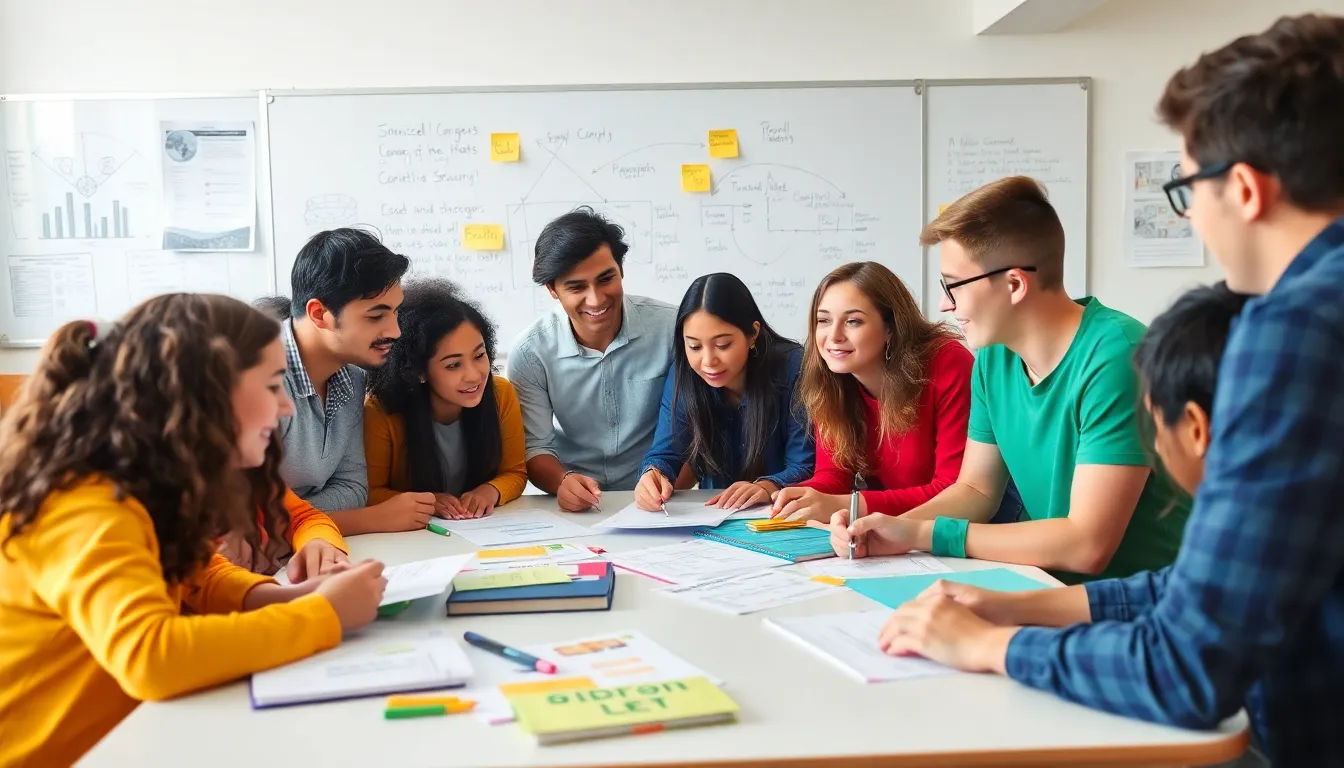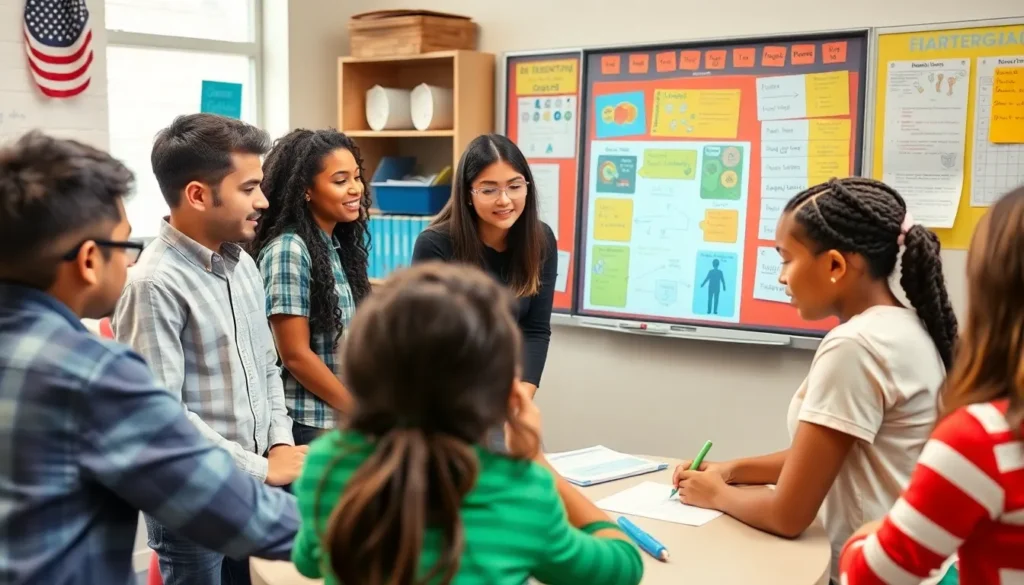Table of Contents
ToggleIn a world where students’ attention spans rival that of a goldfish, keeping them engaged can feel like trying to herd cats. But fear not! Innovative student engagement strategies can transform any classroom into a vibrant hub of activity. Imagine a learning environment where students are not just passive listeners but active participants, eagerly sharing ideas and collaborating with their peers.
Overview of Student Engagement Strategies
Student engagement strategies enhance classroom dynamics and foster active participation. Interactive learning techniques like group discussions and problem-solving exercises encourage collaboration among students. Incorporating technology tools such as educational apps and platforms increases accessibility and engagement levels.
Gamification proves effective in captivating students’ attention. Point systems, leaderboards, and rewards contribute to a motivating learning environment. Likewise, hands-on activities provide practical experiences, making concepts more relatable and easier to grasp.
Differentiated instruction addresses diverse learning styles. Tailoring lessons to accommodate visual, auditory, and kinesthetic learners promotes inclusivity. Regular feedback loops help students track their progress, reinforcing accountability and self-reflection.
Creating a welcoming classroom atmosphere cultivates positive student relationships. Establishing community through icebreaker activities and shared experiences boosts trust and communication among peers. Empowering students by giving them choices in projects or topics enhances ownership and motivation.
Finally, establishing clear expectations and consistent routines supports focused engagement. Setting specific learning goals guides students in their academic pursuits. Collaborative projects allow them to work together toward shared objectives, increasing their commitment to learning.
Implementing these strategies transforms the traditional classroom into a vibrant hub of student interaction. Adopting various methods makes education an exciting and participatory experience.
Importance of Student Engagement

Recognizing the importance of student engagement significantly impacts both learning outcomes and classroom dynamics. Active participation fosters a connection between students and their educational experience.
Benefits for Students
Engaged students demonstrate improved academic performance, resulting in higher grades and test scores. Increased motivation stems from personalized learning opportunities that cater to individual interests. Additionally, students develop critical thinking and social skills through collaboration in group activities. Enhanced retention of knowledge occurs when students actively participate in discussions and hands-on projects. Moreover, a stronger sense of belonging emerges, reducing feelings of isolation and promoting a positive classroom environment.
Benefits for Educators
Educators see enhanced classroom management as engaged students often exhibit fewer behavioral issues. Dynamic classrooms promote creativity among teachers, allowing them to explore innovative teaching methods. Regular feedback from active students provides educators with insights that shape effective instruction. Additionally, a collaborative atmosphere encourages professional growth, creating opportunities for teachers to learn from one another. Ultimately, improved student outcomes reflect positively on educators, fostering a sense of accomplishment and job satisfaction.
Effective Student Engagement Strategies
Effective strategies boost student engagement and enhance learning outcomes. They promote participation and create dynamic learning environments.
Active Learning Techniques
Active learning techniques compel students to engage with the subject matter. Methods like think-pair-share allow students to brainstorm ideas with peers. Incorporating case studies fosters real-world problem solving, encouraging deeper understanding. Peer teaching supports students in explaining concepts to classmates, reinforcing their knowledge. Interactive discussions challenge students to express opinions and ask questions. Creating simulations enables students to experience scenarios firsthand, enhancing retention of information.
Collaborative Learning Approaches
Collaborative learning approaches enhance teamwork and communication skills. Group projects allow students to work together, leveraging each other’s strengths. Structured debates provide opportunities for critical thinking and engaging in healthy discourse. Learning stations create a hands-on experience where students rotate among activities, stimulating interest. Using learning communities fosters connections among peers, promoting a sense of belonging. Assigning roles within groups encourages responsibility while contributing to overall project success.
Technology-Driven Engagement
Technology-driven engagement tools capture student interest and foster interaction. Digital platforms like Google Classroom streamline communication between teachers and students. Interactive quizzes, through tools like Kahoot, turn assessments into enjoyable experiences. Virtual reality offers immersive experiences for subjects that benefit from visualization, such as history and science. Online discussion forums enable students to share insights and resources outside the classroom. Educational apps enhance personalized learning experiences, catering to various needs and preferences while maintaining student focus.
Implementing Engagement Strategies in the Classroom
Implementing effective engagement strategies is essential for transforming classrooms into interactive learning environments. Educators can draw from various approaches to ensure every student’s needs and interests are assessed and addressed.
Assessing Student Needs
Understanding student needs forms the foundation of targeted engagement strategies. Regular assessments, including surveys and informal check-ins, provide insights into individual preferences. Tailored instruction addresses diverse learning styles and allows teachers to adapt their methods. Engaging students in discussions about their interests further enhances relevance and connection to the lessons. Educators can also consider input from parents or guardians to gain a broader perspective on each student’s strengths and challenges. Collectively, these strategies create a personalized learning experience that promotes engagement and accountability.
Designing Engaging Activities
Designing engaging activities fosters active participation among students. Innovative projects that incorporate student interests inspire collaboration and enthusiasm. Active methodologies, such as role-playing and project-based learning, allow students to connect theoretical concepts with real-world applications. Introducing technology tools, like interactive simulations, enhances interest and personalization. Variation in activity formats, including group work and solo tasks, accommodates different learning preferences. Aligning activities with clear learning objectives ensures that engagement also supports academic growth. By prioritizing relevance and creativity in lesson design, educators can cultivate a dynamic classroom atmosphere.
Implementing effective student engagement strategies is essential for creating a vibrant and interactive learning environment. By fostering active participation and collaboration students not only enhance their academic performance but also develop crucial social skills.
Educators who embrace innovative techniques and technology tools can transform traditional classrooms into dynamic spaces that captivate student interest. When students feel empowered and connected to their learning experience they are more likely to thrive.
Ultimately a focus on engagement leads to improved outcomes for both students and teachers making education a more enriching and enjoyable journey.







